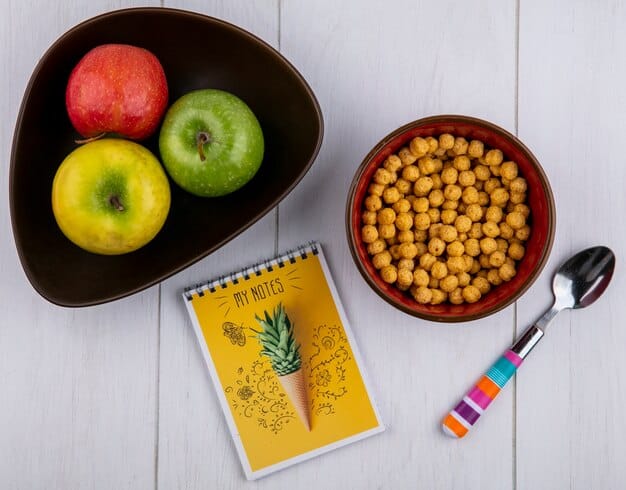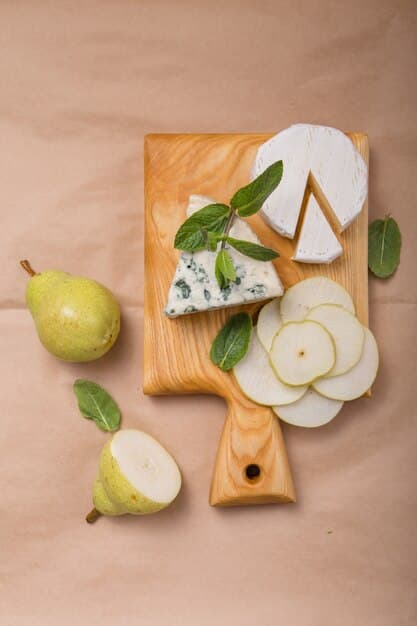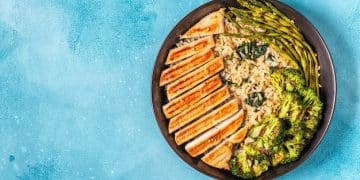The Ultimate Guide to Healthy Snacking: 10 Options Under 200 Calories

Achieving balanced nutrition doesn’t mean sacrificing flavor or feeling deprived; this guide illuminates how to incorporate mindful snacking into your daily routine with ten delicious, easy-to-prepare options, each carefully curated to stay under 200 calories, offering both satisfaction and sustained energy.
In the vibrant landscape of modern wellness, the concept of snacking has undergone a significant transformation. Far from being an indulgence, it has evolved into a strategic component of a balanced diet. This comprehensive resource unveils The Ultimate Guide to Healthy Snacking: 10 Options Under 200 Calories, offering you practical, flavorful choices that align seamlessly with your health goals without compromising on taste or convenience. Let’s delve into a world where smart snacking empowers your well-being.
Understanding the Role of Smart Snacking in Your Diet
The role of snacking in a well-rounded diet is often misunderstood, frequently relegated to an afterthought or a moment of impulse. However, when approached thoughtfully, snacking can become a powerful tool for managing hunger, sustaining energy levels, and even enhancing your overall nutrient intake. It’s about making conscious choices that support your body’s needs throughout the day, rather than simply tiding you over until the next meal.
Strategic snacking can prevent the intense hunger that often leads to overeating at main meals, helping to maintain stable blood sugar levels. This stability is crucial for energy and focus, averting the dreaded mid-afternoon slump. Furthermore, well-chosen snacks provide an opportunity to bridge nutritional gaps, ensuring you consume a wider array of vitamins, minerals, and fiber that might be missed if you only focus on breakfast, lunch, and dinner.
The Difference Between Mindless and Mindful Snacking
Mindless snacking typically occurs out of habit, boredom, or stress, often involving highly processed foods that offer little nutritional value. This approach can lead to excess calorie consumption and a feeling of dissatisfaction. In contrast, mindful snacking involves intentionally selecting nourishing foods, paying attention to your body’s hunger cues, and savoring the experience.
- Mindless Snacking Pitfalls: Eating while distracted, emotional eating, consuming empty calories.
- Mindful Snacking Benefits: Enhanced satiety, better portion control, appreciation for food.
- Key to Success: Planning and preparation are foundational for turning mindless habits into mindful nourishment.
By understanding this distinction, you can begin to shift your snacking habits from reactive to proactive. It means recognizing genuine hunger versus emotional cravings and making choices that truly serve your body. The goal is to feel satisfied and energized, not just temporarily full. This foundational understanding sets the stage for exploring specific healthy snack options that fit within a balanced dietary framework, leading to improved health and well-being.
Unveiling Our Top 10 Healthy Snack Options Under 200 Calories
Navigating the world of healthy snacks can be daunting, but with the right guidance, it becomes an exciting journey of discovery. Our expertly curated list features ten incredible options, each designed to be delicious, satisfying, and reliably under the 200-calorie mark. These snacks are not just low in calories; they are packed with nutrients, fiber, and protein to keep you feeling full and energized. We’ve focused on accessibility, ease of preparation, and the ability to fit seamlessly into any busy lifestyle, whether you’re at home, at work, or on the go.
1. Apple Slices with a Tablespoon of Peanut Butter (Approx. 190 Calories)
This classic combination is a powerhouse of nutrition and flavor. The fiber from the apple provides sustained energy and aids digestion, while the healthy fats and protein in peanut butter offer a satisfying feeling of fullness. Opt for natural peanut butter with minimal added sugar and salt for the best health benefits. This snack is incredibly versatile and easy to pack, making it perfect for any time of day.
- Benefits: High in fiber, good source of healthy fats and protein, easily portable.
- Preparation Tip: Pre-slice apples and portion peanut butter into small containers for quick grabs.
2. Greek Yogurt with a Handful of Berries (Approx. 150-180 Calories)
Greek yogurt is celebrated for its high protein content, which is essential for muscle repair and satiety. When paired with a vibrant mix of berries—strawberries, blueberries, raspberries—you add a burst of antioxidants, vitamins, and natural sweetness without excessive sugar. Choose plain, unsweetened Greek yogurt to control sugar intake and enjoy the pure flavors.
3. A Hard-Boiled Egg and 10 Almonds (Approx. 170 Calories)
Eggs are often referred to as nature’s perfect food, offering a complete protein profile with all nine essential amino acids. Combined with almonds, which are packed with healthy fats, fiber, and a good dose of protein, this snack delivers a powerful punch of sustained energy. Hard-boiling eggs in advance makes this a super convenient option for busy days. Almonds provide a satisfying crunch that also contributes to feelings of fullness.

4. Small Orange and a Small Handful of Walnuts (Approx. 160 Calories)
The bright tang of an orange, brimming with Vitamin C and fiber, beautifully complements the earthy richness of walnuts. Walnuts are exceptional for their omega-3 fatty acids, which support brain health and reduce inflammation. This duo is a fantastic choice for an afternoon pick-me-up, offering both sweet refreshment and a satisfying crunch. It’s a simple, yet profoundly nutritious combination that fits perfectly within the calorie target.
5. Half an Avocado with a Pinch of Salt and Pepper (Approx. 160 Calories)
Avocados are a beloved superfood, renowned for their heart-healthy monounsaturated fats, fiber, and potassium. Eating half an avocado, perhaps sprinkled with a dash of sea salt and freshly ground pepper, makes for an incredibly satisfying and creamy snack. It’s surprisingly filling and helps keep cravings at bay. This option is particularly good for those seeking a savory, nutrient-dense bite.
6. Rice Cakes with Smoked Salmon (Approx. 190 Calories)
For a sophisticated and protein-rich snack, two plain rice cakes topped with a small portion of smoked salmon can be delicious. Smoked salmon provides excellent omega-3s and high-quality protein, while rice cakes offer a light, crisp base. This combination is quick to assemble and feels more substantial than its calorie count suggests, making it an ideal choice when you crave something savory and flavorful.
7. One Cup of Celery Sticks with 2 Tablespoons of Hummus (Approx. 150 Calories)
Celery is a low-calorie, hydrating vegetable, and when paired with hummus, it transforms into a delectable and nutrient-dense snack. Hummus, made from chickpeas, tahini, olive oil, and lemon juice, is rich in plant-based protein and fiber, promoting satiety and digestive health. This dynamic duo offers a satisfying crunch and creamy texture, making it a favorite for many.
8. A Small Pear and 1 Ounce (Approx. 28g) of Low-Fat Cheese (Approx. 180 Calories)
The natural sweetness and fiber of a small pear pair wonderfully with the savory notes of low-fat cheese. Cheese provides calcium and protein, contributing to bone health and fullness. This snack offers a lovely balance of sweet and savory flavors, along with a good mix of macronutrients, making it a well-rounded and comforting option for any time of day. It’s also incredibly easy to prepare and enjoy.

9. Edamame (½ Cup Shelled, Steamed) (Approx. 100 Calories)
Edamame, or young soybeans, are an excellent source of plant-based protein, fiber, and essential nutrients. Steamed and lightly salted, they make for a highly satisfying and wholesome snack. The act of shelling them can also be quite meditative, slowing down the eating process and promoting mindful consumption. They are naturally gluten-free and cholesterol-free, making them a superb choice for a wide range of dietary preferences.
10. Air-Popped Popcorn (3 Cups) with No Butter (Approx. 90 Calories)
When prepared without butter or excessive oil, air-popped popcorn is a surprisingly healthy and low-calorie snack. It’s a whole grain that offers a good amount of fiber, which helps with satiety. The large volume provides a feeling of fullness without many calories, making it ideal when you want to munch on something crunchy and light. Season with a sprinkle of nutritional yeast for a cheesy flavor or a dash of cinnamon for a sweet twist.
These ten options demonstrate that healthy snacking is not about deprivation, but about intelligent substitution and creative combinations. Each choice is carefully balanced to deliver satiety and nutrition within the 200-calorie limit, proving that smart snacks can be both delicious and incredibly beneficial for your overall health journey.
Strategies for Incorporating Healthy Snacking into Your Routine
Integrating healthy snacking into your daily life requires more than just knowing what to eat; it demands thoughtful planning and the cultivation of sensible habits. Merely having a list of options is a good start, but understanding how to consistently implement these choices is where true success lies. This section provides actionable strategies to make healthy snacking a seamless and enjoyable part of your routine, ensuring you stay on track with your nutritional goals.
Planning and Preparation: The Foundation of Success
The cornerstone of healthy snacking is advanced planning and preparation. Impulse choices often lead to less nutritious options because they are convenient. By taking a little time to prepare, you can ensure that wholesome snacks are always within reach. This might involve a dedicated “snack prep” session each week, similar to meal prepping, where you portion out items or chop vegetables. Store these prepped snacks in clear containers in a visible spot in your refrigerator or pantry. This makes healthy choices quicker and more appealing than less healthy alternatives when hunger strikes.
Furthermore, consider how your snacks fit into your overall caloric and nutritional goals. While each of the 10 options presented is under 200 calories, the frequency and timing of your snacks also matter. Align your snacking with your personal energy needs and activity levels. For instance, a mid-morning snack might bridge the gap between breakfast and a late lunch, while an afternoon snack could fuel a workout or prevent overeating at dinner. Listening to your body’s true hunger signals is paramount here.
Avoiding Common Snacking Pitfalls
Even with the best intentions, several common pitfalls can derail healthy snacking efforts. Awareness of these traps is the first step toward avoiding them. One major pitfall is emotional eating—snacking out of boredom, stress, or sadness rather than genuine hunger. Cultivating mindfulness around why you’re reaching for a snack can help you identify and address these non-hunger cues. Instead of food, consider alternative coping mechanisms like a short walk, a quick meditation, or engaging in a hobby.
Another pitfall is going too long between meals, which can lead to extreme hunger and impulsive, unhealthy choices. Planning your snacks to occur every 3-4 hours if needed can help prevent this. Also, be wary of “health halos” – foods marketed as healthy but laden with hidden sugars, unhealthy fats, or excessive calories. Always read nutrition labels carefully, especially for packaged snacks. Focusing on whole, unprocessed foods as much as possible is always the safest bet.
- Mindful Eating: Pay attention to hunger cues, eat slowly, and savor each bite.
- Portion Control: Measure out snacks to avoid overeating, especially with calorie-dense options like nuts.
- Hydration: Sometimes thirst is mistaken for hunger; drink a glass of water before reaching for a snack.
By implementing these strategies, you can transform snacking from a potential diet challenge into a powerful ally in your journey toward better health. It’s about building sustainable habits that support your well-being, one thoughtful snack choice at a time.
The Scientific Backing: Why These Snacks Work for Weight Management
The effectiveness of our selected healthy snack options isn’t just anecdotal; it’s firmly rooted in nutritional science. Each of the 10 featured snacks works synergistically to support weight management, not by starvation or deprivation, but by promoting satiety, stabilizing blood sugar, and providing essential nutrients. Understanding the science behind these choices empowers you to make informed decisions that genuinely contribute to your health goals.
Satiety: The Role of Protein and Fiber
One of the primary reasons these snacks are effective is their strategic combination of protein and fiber. Protein is the most satiating macronutrient, meaning it helps you feel full for longer and reduces overall calorie intake. It slows down digestion and influences hormones that signal fullness to the brain. This is why options like Greek yogurt, hard-boiled eggs, and edamame are so valuable. The protein content helps prevent that “empty stomach” feeling that often leads to overeating at the next meal.
Fiber, particularly soluble fiber, also plays a critical role in satiety. It adds bulk to food without contributing calories, creating a feeling of fullness. Fiber also slows down the absorption of sugar, contributing to more stable blood glucose levels. Items like apples, berries, and air-popped popcorn are rich in fiber, which contributes to a sustained feeling of satisfaction and can aid in weight loss by reducing overall hunger and calorie consumption throughout the day. When protein and fiber are combined, as in many of our snack suggestions, their satiating effects are amplified.
Blood Sugar Regulation and Energy Stability
Another key benefit of these snacks is their ability to help regulate blood sugar levels. Snacks high in refined carbohydrates and sugar cause rapid spikes and crashes in blood glucose, leading to energy fluctuations, increased hunger, and often, cravings for more sugary foods. Our recommended snacks, such as apple slices with peanut butter or Greek yogurt with berries, are designed to minimize these dramatic swings.
The combination of complex carbohydrates (like those in apples and pears) with healthy fats (from peanut butter, avocados, almonds, walnuts) and protein (from yogurt, eggs, salmon) ensures a slower and more gradual release of glucose into the bloodstream. This sustained release helps maintain consistent energy levels, preventing the mid-day slumps and the associated cravings that can derail healthy eating habits. Stable blood sugar is crucial not only for energy but also for minimizing fat storage, making these snacks an intelligent choice for weight management.
These scientific principles underpin the selection of our top 10 healthy snacks. By focusing on nutrient density, satiety signals, and blood sugar stability, these options offer a sustainable and enjoyable path to managing weight and improving overall health, proving that smart choices can lead to significant benefits.
Beyond Calories: Nutrient Density and Health Benefits
While the 200-calorie threshold is a useful guideline for weight management, the true value of a snack extends far beyond its caloric count. Nutrient density—the amount of beneficial nutrients per calorie—is a crucial factor in building a healthy diet. Our selection of 10 healthy snacks excels in this regard, offering a wealth of vitamins, minerals, antioxidants, and healthy fats that contribute significantly to overall well-being, transforming a simple snack into a powerful health tool.
Micronutrients and Antioxidants Galore
Many of our featured snacks are veritable powerhouses of micronutrients and antioxidants. Berries, for instance, are bursting with Vitamin C, manganese, and powerful antioxidants called anthocyanins, which combat oxidative stress and inflammation. Oranges boast an impressive Vitamin C content, essential for immune function and skin health, complementing the omega-3 fatty acids found in walnuts, known for their brain-boosting properties.
Celery and hummus provide a good source of Vitamin K, folate, and iron, crucial for blood clotting, cell division, and oxygen transport, respectively. Even seemingly simple choices like air-popped popcorn contribute to health with dietary fiber and antioxidants. By incorporating a variety of these nutrient-dense options, you’re not just staving off hunger; you’re actively fortifying your body with essential compounds that protect against disease and support optimal bodily functions.
Heart-Healthy Fats and Protein Power
The healthy unsaturated fats found in avocados, almonds, walnuts, and peanut butter are vital for heart health. These fats can help lower bad cholesterol (LDL) and raise good cholesterol (HDL), reduce inflammation, and support brain function. Unlike saturated or trans fats, which can negatively impact cardiovascular health, monounsaturated and polyunsaturated fats are cornerstones of a heart-protective diet. They also contribute significantly to satiety, making you feel full and satisfied without overeating.
Protein, abundantly present in Greek yogurt, hard-boiled eggs, edamame, and smoked salmon, is fundamental for more than just satiety. It is the building block for muscles, enzymes, hormones, and various bodily tissues. Adequate protein intake is critical for muscle repair and growth, metabolic health, and maintaining a healthy immune system. Including these protein-rich snacks ensures your body has the raw materials it needs to function optimally throughout the day, providing sustained energy and supporting overall physiological health, far beyond just managing hunger.
Shifting focus from merely calorie counting to nutrient density allows for a more holistic approach to snacking. It encourages choices that not only help with weight management but also enhance vitality and long-term health, illustrating that every bite can contribute to a more robust and resilient body.
The Adaptability of Healthy Snacking for Diverse Lifestyles
One of the remarkable advantages of our curated list of 10 healthy snack options is their inherent adaptability. In a world defined by diverse dietary needs, busy schedules, and varying preferences, snacks must be versatile. These choices are not rigid prescriptions but rather flexible templates that can be easily customized to fit a multitude of lifestyles, ensuring that healthy eating remains accessible and enjoyable for everyone.
Fitting Snacks into Busy Schedules
For individuals with demanding schedules, convenience is key. Most of our 10 suggestions require minimal preparation, or can be prepped in bulk, making them ideal for grab-and-go scenarios. Hard-boiled eggs can be made on Sunday for the entire week; portioned almonds and walnuts can be stored in small baggies; and fruit like apples and oranges are naturally self-contained and portable. Pre-cut celery and pre-portioned hummus can be quickly assembled. Even air-popped popcorn can be prepared in larger batches and stored, ready for a quick serving. The emphasis on simplicity and portability ensures that even the busiest professionals or parents can maintain their commitment to healthy eating without feeling overwhelmed.
- Morning Snacker: Greek yogurt with berries or a hard-boiled egg.
- Afternoon Pick-Me-Up: Apple slices with peanut butter or a small pear with low-fat cheese.
- Evening Craving: Air-popped popcorn or a handful of edamame.
Customization for Dietary Preferences and Restrictions
Our healthy snack options are also highly adaptable to various dietary preferences and restrictions, making them inclusive for a broad audience. For instance, those following a vegetarian or vegan diet can easily incorporate options like apples with peanut butter, celery with hummus, edamame, and air-popped popcorn. Lactose- intolerant individuals can opt for nut-based snacks, fruits, or plant-based yogurts (adjusting for calorie content). For individuals with nut allergies, seeds (like sunflower or pumpkin seeds) can often be substituted for nuts, or focus can be placed on fruit, vegetables, and dairy-free options.
Similarly, for those managing specific health conditions, these snacks provide a stable foundation. Diabetics can benefit from the low glycemic index of options rich in fiber and protein, which help manage blood sugar levels. Individuals focused on heart health can emphasize choices high in healthy fats, such as avocados, almonds, and walnuts. The inherent flexibility means that while the core selections remain the same, individual adjustments ensure that everyone can leverage these snacks for their personal health journey, reinforcing that healthy eating is not a one-size-fits-all approach but a personalized path.
Making Healthy Snacking a Sustainable Lifestyle Choice
Transforming healthy snacking from an occasional effort into a sustainable lifestyle choice is the ultimate goal. It’s about developing habits that feel natural, enjoyable, and seamlessly integrated into your daily routine. By embracing a holistic perspective that combines knowledge, practical application, and a positive mindset, you can ensure that smart snacking becomes a long-term ally in your pursuit of optimal health and well-being.
Building Sustainable Habits
The key to sustainability lies in consistency and making small, incremental changes rather than drastic overhauls. Start by incorporating one or two new healthy snack options into your week and gradually expand as you become more comfortable. This gradual approach minimizes feelings of deprivation and increases the likelihood of long-term adherence. For example, begin by swapping your usual processed snack for an apple with peanut butter, and once that feels routine, introduce Greek yogurt with berries.
Create a supportive environment by stocking your kitchen with these healthy choices and removing tempting, less nutritious options. The saying “out of sight, out of mind” holds true here. Make healthy snacking the easy and obvious choice. Think of snacking not as a chore, but as an opportunity to nourish your body and boost your energy. Celebrate small victories and acknowledge your progress, which reinforces positive behavior and encourages continued effort.
Enjoying the Journey: Flavor and Variety
Variety is not just the spice of life; it’s also crucial for sustainable healthy eating. Regularly rotating your snack choices from our list of 10 options prevents boredom and ensures a broader intake of nutrients. Experiment with different pairings—try various types of berries with your yogurt, or different nuts with your fruit. Explore various seasonings for your air-popped popcorn beyond just salt, like cinnamon or chili powder, to keep things interesting and flavorful.
Healthy eating should never feel restrictive or bland. Embrace the natural flavors of whole foods and discover new favorites. Remember that healthy snacking is about adding value to your diet, not subtracting enjoyment. When you genuinely enjoy the foods you eat, and they make you feel good, it becomes much easier to maintain those habits over the long haul. This positive feedback loop—eating well, feeling well, continuing to eat well—is what truly transforms episodic healthy eating into a sustainable and fulfilling lifestyle.
By focusing on consistency, creating a supportive environment, and embracing variety and flavor, healthy snacking becomes an intuitive and enjoyable part of your daily life, contributing significantly to your overall health journey for years to come.
| Key Point | Brief Description |
|---|---|
| 🍎 Sustained Energy | Fiber and protein in snacks like apples & peanut butter prevent energy crashes. |
| ⚖️ Weight Management | Low-calorie, nutrient-dense options promote fullness and reduce overall intake. |
| ✨ Nutrient Boost | Snacks like Greek yogurt & berries offer essential vitamins, minerals, and antioxidants. |
| ⏰ Time-Efficient | Easy-to-prepare and portable options fit perfectly into busy lifestyles. |
Frequently Asked Questions About Healthy Snacking
The ideal snacking frequency varies based on individual needs, activity levels, and meal timing. Generally, 1-2 snacks per day, positioned between main meals (e.g., mid-morning and mid-afternoon), can help manage hunger and maintain stable energy. Listen to your body’s hunger cues rather than snacking out of habit or boredom. If you’re genuinely not hungry, skipping a snack is perfectly fine.
Yes, strategic healthy snacking can certainly aid in weight loss. By choosing nutrient-dense, portion-controlled snacks, you can prevent excessive hunger, which often leads to overeating at main meals. Snacks rich in protein and fiber promote satiety, helping you feel fuller for longer and reducing overall calorie intake throughout the day. They also help stabilize blood sugar, curbing cravings for unhealthy options.
A healthy snack should primarily offer nutritional value beyond just calories. Look for options rich in protein, which supplies satiety, and fiber, which aids digestion and promotes fullness. Healthy fats are also beneficial for sustained energy. Avoid snacks high in added sugars, unhealthy fats, and artificial ingredients. Focus on whole, unprocessed foods like fruits, vegetables, nuts, seeds, and lean proteins.
These low-calorie snacks are generally suitable for most healthy adults aiming for balanced nutrition and weight management. However, individual dietary needs and restrictions (e.g., allergies, specific medical conditions, extreme activity levels) might require adjustments. Always consult with a healthcare professional or registered dietitian for personalized dietary advice, especially if you have underlying health concerns.
Convenience is key for busy individuals. Dedicate time for snack prep at the beginning of the week by washing and chopping fruits/vegetables, portioning out nuts, or hard-boiling eggs. Store prepped snacks in easily accessible containers. Keep non-perishable options like nuts, dried fruit (in moderation), or rice cakes at your office or in your bag. Planning ahead eliminates last-minute unhealthy choices.
Conclusion
Embracing healthy snacking is a proactive step toward a more balanced and energized lifestyle. This guide, “The Ultimate Guide to Healthy Snacking: 10 Options Under 200 Calories,” demonstrates that nourishing your body effectively doesn’t require complex meal plans or deprivation. By intelligently incorporating these delicious, nutrient-dense, and satisfying options into your daily routine, you can effectively manage hunger, stabilize energy levels, and enhance your overall well-being. Smart snacking is not just about counting calories; it’s about making deliberate choices that fuel your body and support your journey to optimal health.





